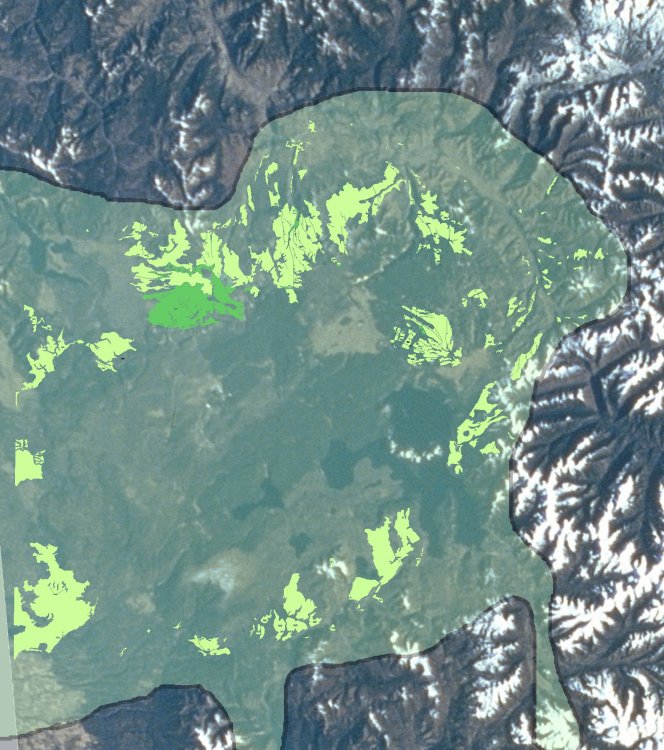Volcanic Obsidian
Obsidian is a massive volcanic glass. The term ‘massive’ has several (although related) meanings in geology but here it means that the rock (obsidian is a rock type, not a mineral) is homogenous. It lacks layering, cleavage, foliation, phenocrysts, etc. It is just a piece of volcanic glass without further conditions. In the majority of cases obsidian solidified subaerially (on land). Volcanic glass that formed underwater has alternative names like tachylite and hyaloclastite.
Hotter Side of Obsidian (By K. Weldon, 2010) Formation of That Black Glass Obsidian. Volcanic glasses such as obsidian form when some physical property of lava restricts ion mobility preventing an ordered crystalline pattern to develop, and for obsidian it is the viscosity that has the greatest control on the ordered crystalline pattern, the measure of viscosity is dependent on the temperature. Obsidian: Volcanic Glass. When you buy a gem, you want to be sure that it is a natural stone and not glass. But there is one kind of natural gemstone that actually is glass. Obsidian is naturally occurring volcanic glass. It is formed when felsic lava extruded from a volcano cools without crystal growth.
Typical obsidian is either black or slightly reddish and often demonstrates beautiful conchoidal fracture. Width of sample 11 cm.
So the volcanic glass and obsidian are not synonyms although in many cases you can freely use both terms. It is definitely not wrong to use ‘volcanic glass’ instead of ‘obsidian’ but you should be careful the other way around — volcanic glass is not always obsidian.


Volcanic glass is an igneous rock that is composed of largely uncrystallized magmatic material. Most of it is not crystallized because the crystals had two difficult problems which restricted their growth. The first one is time. Large crystals need a lot of time to grow. There is very little of it when viscous magma is pushed out of a volcano and cools rapidly. I already gave a subtle hint what the second problem might be. It is the viscosity of magma/lava. If the magmatic body is very thick or viscous, the crystals have a really hard time forming because they simply don’t have new material coming in if almost nothing is able to move inside the magma body. The result is that everything solidifies just randomly as glass.
So obsidian forms from viscous magma only? Usually yes, but not always. Most obsidians are rhyolitic in composition. This lava is the thickest because it has the highest silica content. Why is that important? Because silica causes magma to polymerize. There are countless bridges (chemical bonds) between oxygen anions of silica (SiO2) which is the reason why this magma is so hard to move. If the magma contains lots of metals (cations) then it is less viscous because these cations break the framework structure of silica. I think this point is important and worth paying attention to because lots of people seem to think that rhyolitic magma is more viscous than basaltic magma only because its temperature is usually lower.
Vesicular basaltic volcanic glass from Punalu’u Beach, Hawaii. Width of view 20 mm.
Obsidian with gray layers of rhyolitic pumice in Long Valley Caldera in California. Pumice and rhyolite have very similar composition but they differ in texture — pumice is highly vesicular while obsidian is massive.
Is some volcanic glass still basaltic in composition? Yes, but in this case the cooling has been really rapid. This is the case if basaltic lava is flowing into the water. There are some nice black sand beaches in Hawai’i that are composed of fragments of volcanic glass with basaltic composition.
Obsidian Cooling Rate
How to identify small obsidian fragments like sand grains? In most cases it is not too hard to do by optical examination only. Obsidian is usually black although reddish varieties are pretty common also. Obsidian has a strong luster and conchoidal fracture. This means that fracture surface is smoothly curving (like a seashell).
Obsidian is usually black. This color is caused by minute inclusions and tiny crystals in the glass. Red color is caused by the same stuff that gives red color to weathered basalt, desert sand and K-feldspar. It is mineral hematite (iron oxide).
Obsidian is usually dark and its surface is shiny.
Obsidian Volcanic Rock
Obsidian is not stable in the weathering environment but it does not mean that it can not last millions of years. Obsidian on the Moon may be billions of years old because the Moon is dry. The same applies here on the Earth as well. In dry areas obsidian can last pretty long. However, obsidian formations older than the Cenozoic (it began 65 million years ago) are unknown.
Volcanic Obsidian Glass
Here are two pictures of obsidian grains picked from coarse-grained sand samples.
Obsidian from the Yellowstone National Park. Width of view 35 mm.
Contents Of Volcanic Emissions
Obsidian from NE California (The Cascades volcanic range). Width of view 22 mm.
